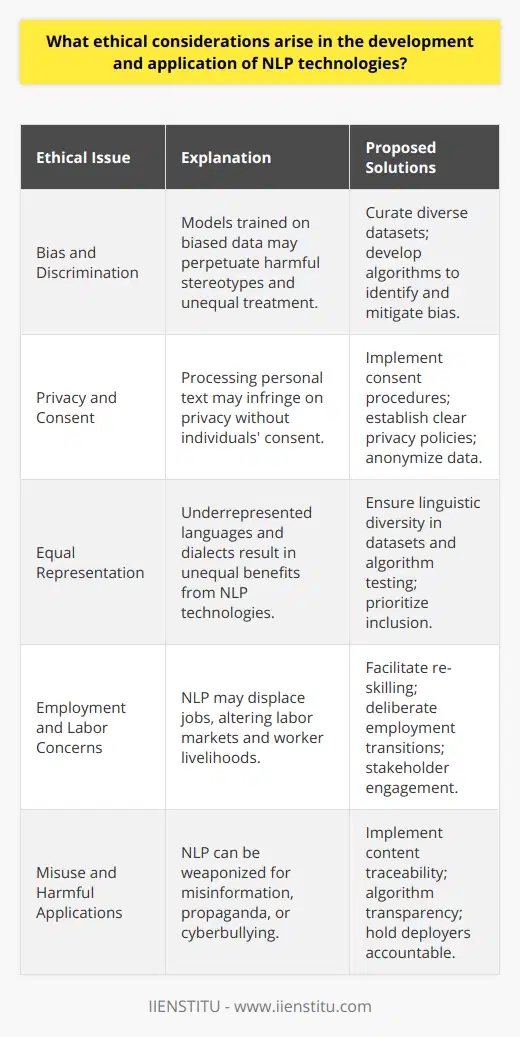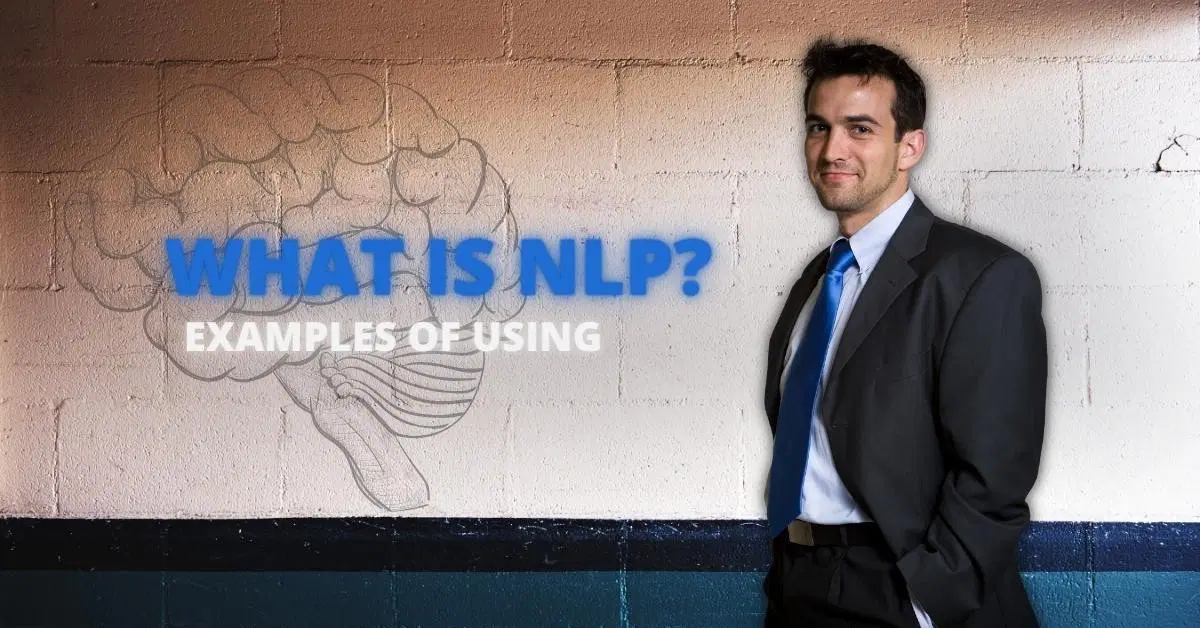
Neuro-Linguistic Programming (NLP) is a powerful set of tools and techniques that can help individuals understand and optimize their thought processes, emotions, and behaviors. By utilizing NLP techniques, we can gain a deeper understanding of ourselves and others, leading to improved communication skills, better decision-making, and enhanced personal development. In this article, we will explore the various benefits of NLP and how it can be applied in everyday life to overcome challenges and achieve personal growth.
One of the primary reasons to use NLP is its ability to help individuals manage anxiety effectively. NLP techniques for anxiety management involve identifying the root cause of anxious thoughts and feelings, and then reframing them in a more positive light. For example, if you find yourself constantly worrying about a specific situation, NLP can help you break down that worry into smaller, more manageable parts. By understanding the underlying fears and beliefs that contribute to your anxiety, you can work towards replacing them with more empowering thoughts and behaviors. As Dr. Richard Bandler, co-founder of NLP, states in his book "Get the Life You Want: The Secrets to Quick and Lasting Life Change with Neuro-Linguistic Programming," "NLP is a way of thinking that leaves behind negative thoughts and behaviors, and replaces them with positive ones" (Bandler, 2008, p. 23).
Another significant benefit of NLP is its ability to improve communication skills. Effective communication is essential in all areas of life, from personal relationships to professional settings. NLP provides a framework for understanding how individuals process information and communicate with others. By learning to recognize and interpret nonverbal cues, such as body language and tone of voice, you can become a more effective communicator. Additionally, NLP techniques can help you develop greater empathy and rapport with others, allowing you to build stronger, more meaningful connections. In their book "NLP: The Essential Guide to Neuro-Linguistic Programming," Tom Hoobyar and Tom Dotz emphasize the importance of rapport in communication, stating, "Rapport is the ability to relate to others in a way that creates trust and understanding. It is the ability to see the other person's point of view and to appreciate their feelings" (Hoobyar & Dotz, 2013, p. 78).
NLP also offers a range of practices for personal development and growth. By understanding your own thought patterns and beliefs, you can work towards creating positive changes in your life. NLP techniques such as goal-setting, visualization, and affirmations can help you clarify your desires and motivate you to take action towards achieving them. For example, by visualizing yourself successfully completing a challenging task or reaching a desired goal, you can increase your confidence and motivation to pursue it. As Dr. Joseph O'Connor explains in his book "Introducing NLP: Psychological Skills for Understanding and Influencing People," "NLP is a set of tools and techniques for creating change. It is a way of thinking about how the mind works, and how we can use the power of the mind to create the life we want" (O'Connor, 2001, p. 3).
In addition to personal development, NLP can also be incredibly beneficial for emotional regulation. By gaining a deeper understanding of your emotions and how they influence your thoughts and behaviors, you can learn to manage them more effectively. NLP techniques such as anchoring and reframing can help you develop greater emotional resilience and adaptability. Anchoring involves associating a specific emotional state with a particular trigger, such as a word or gesture, allowing you to access that state when needed. Reframing involves changing the way you perceive a situation or experience, helping you to find new, more positive perspectives. In their book "Beliefs: Pathways to Health and Well-Being," Robert Dilts, Tim Hallbom, and Suzi Smith discuss the power of reframing, stating, "Reframing is the process of changing the way you perceive an event and thus changing the meaning. When the meaning changes, responses and behaviors also change" (Dilts, Hallbom, & Smith, 1990, p. 45).
Another key benefit of NLP is its ability to enhance decision-making skills. By understanding your own thought processes and biases, you can make more informed and rational decisions. NLP techniques such as the "Disney Strategy" can help you approach decision-making from multiple perspectives, allowing you to weigh the pros and cons of each option more effectively. The Disney Strategy involves considering a decision from three different perceptual positions: the dreamer, the realist, and the critic. By exploring a decision from each of these viewpoints, you can gain a more comprehensive understanding of the situation and make a well-rounded choice. As Robert Dilts explains in his book "Strategies of Genius: Volume One," "The Disney Strategy is a powerful tool for creative problem-solving and decision-making. It allows you to access different aspects of your intelligence and creativity, and to use them in a coordinated way" (Dilts, 1994, p. 157).
NLP can also be a valuable tool for building self-confidence. By identifying and challenging limiting beliefs and negative self-talk, you can develop a more positive and empowering self-image. NLP techniques such as the "Swish Pattern" can help you replace negative thoughts and images with more positive ones, gradually building your confidence over time. The Swish Pattern involves visualizing a desired state or behavior and then "swishing" it with a current, less desirable state. By repeatedly practicing this technique, you can train your mind to automatically replace negative thoughts with positive ones. As Dr. Richard Bandler and John La Valle explain in their book "Persuasion Engineering," "The Swish Pattern is a powerful technique for creating rapid and lasting change. It works by directly accessing the unconscious mind and replacing old, unwanted behaviors with new, more desirable ones" (Bandler & La Valle, 1996, p. 83).
One of the most valuable aspects of NLP is its practicality and applicability to everyday life. NLP techniques can be used in a wide range of contexts, from personal relationships to professional settings. For example, using NLP techniques to build rapport and communicate effectively can help you navigate difficult conversations and resolve conflicts more smoothly. In the workplace, NLP can be used to enhance leadership skills, improve team dynamics, and increase productivity. As Sue Knight emphasizes in her book "NLP at Work: The Essence of Excellence," "NLP is not just a set of techniques; it is a way of thinking and a way of being. It is a way of exploring the world around you and your place in it. It is a way of understanding yourself and others, and of using that understanding to create positive change" (Knight, 2009, p. 1).
The effectiveness of NLP lies in its ability to harness the power of neuroplasticity, the brain's ability to reorganize itself and form new neural connections in response to learning and experience. By repeatedly practicing NLP techniques, you can rewire your brain to think and respond in more positive and productive ways. This process of neuroplasticity and NLP training is supported by research in the field of neuroscience. For example, a study published in the journal "PLOS One" found that NLP training was associated with increased gray matter density in brain regions involved in emotional regulation and self-awareness (Lee et al., 2015).
Another key concept in NLP is the idea of cognitive maps. Cognitive maps refer to the mental representations we create of the world around us, including our beliefs, values, and experiences. These maps shape our perceptions and guide our behaviors, often on an unconscious level. By understanding cognitive maps in NLP, you can gain insight into your own thought processes and those of others, allowing you to communicate and interact more effectively. As Alfred Korzybski, the founder of general semantics, famously stated, "The map is not the territory" (Korzybski, 1933, p. 58). In other words, our cognitive maps are not an exact representation of reality, but rather a subjective interpretation based on our unique experiences and beliefs.

Finally, NLP can be a powerful tool for overcoming fears and phobias. By using techniques such as the "Fast Phobia Cure," individuals can quickly and effectively overcome irrational fears and anxieties. The Fast Phobia Cure involves guiding the individual through a series of mental exercises designed to dissociate the fear response from the triggering stimulus. By reprocessing the memory of the phobic event in a more neutral and detached way, the individual can break free from the grip of fear and regain control over their emotions. As Dr. Richard Bandler explains in his book "Using Your Brain for a Change," "The Fast Phobia Cure is a powerful technique for rapidly and permanently eliminating phobias. It works by changing the way the brain processes and stores the memory of the phobic event" (Bandler, 1985, p. 145).
In conclusion, Neuro-Linguistic Programming offers a comprehensive set of tools and techniques for personal growth, emotional regulation, and effective communication. By understanding and applying NLP principles in everyday life, individuals can overcome challenges, build stronger relationships, and achieve their goals with greater ease and confidence. As the field of NLP continues to evolve and expand, it is clear that its potential for creating positive change is limitless. By harnessing the power of our minds and the plasticity of our brains, we can all work towards becoming the best versions of ourselves and creating the lives we truly desire.
References:
Bandler, R. (1985). Using Your Brain for a Change. Real People Press.
Bandler, R., & La Valle, J. (1996). Persuasion Engineering. Meta Publications.
Bandler, R. (2008). Get the Life You Want: The Secrets to Quick and Lasting Life Change with Neuro-Linguistic Programming. Health Communications, Inc.
Dilts, R., Hallbom, T., & Smith, S. (1990). Beliefs: Pathways to Health and Well-Being. Metamorphous Press.
Dilts, R. (1994). Strategies of Genius: Volume One. Meta Publications.
Hoobyar, T., & Dotz, T. (2013). NLP: The Essential Guide to Neuro-Linguistic Programming. William Morrow Paperbacks.
Knight, S. (2009). NLP at Work: The Essence of Excellence. Nicholas Brealey Publishing.
Korzybski, A. (1933). Science and Sanity: An Introduction to Non-Aristotelian Systems and General Semantics. Institute of General Semantics.
Lee, Y. H., Woo, J. H., Choi, S. J., Ji, J. D., & Song, G. G. (2015). Effect of NLP psychotherapy on psychological characteristics and salivary cortisol in patients with systemic lupus erythematosus. PLOS One, 10(11), e0142167.
O'Connor, J. (2001). Introducing NLP: Psychological Skills for Understanding and Influencing People. Thorsons.
Frequently Asked Questions
Why use NLP?
People commonly use NLP techniques. Because they can extract sentiment data from text, understand the meaning behind words, detect sentiment polarity, including anger lexicon or specific rage lexicon.
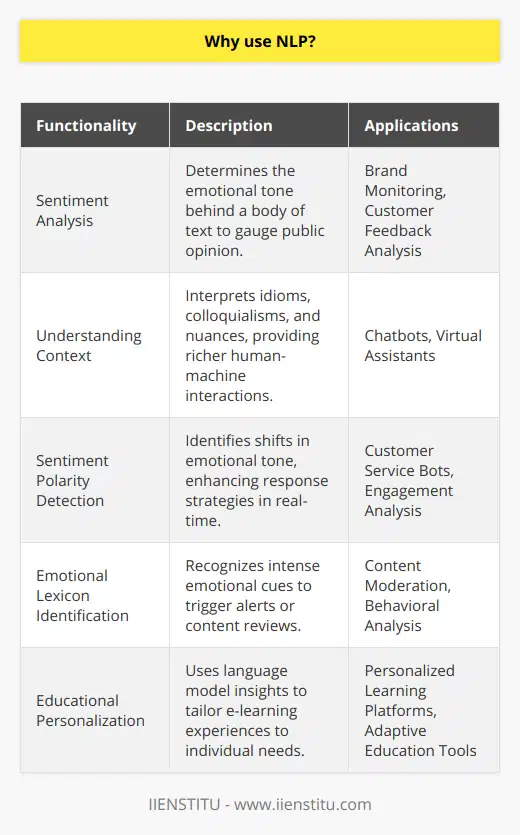
What are the benefits of NLP?
NLP is a behavioral change approach that enables individuals to explore and adjust how they think, act, and communicate with others. The benefits of NLP are many.

What are the examples of using NLP?
There are many ways to use Neuro-Linguistic Programming (NLP) techniques. One of the essential NLP techniques is influencing and persuading people through non-verbal communications. Mind reading and influencing can be mastered and used in several settings, including courtship, sales, counseling, negotiations, and interviews.
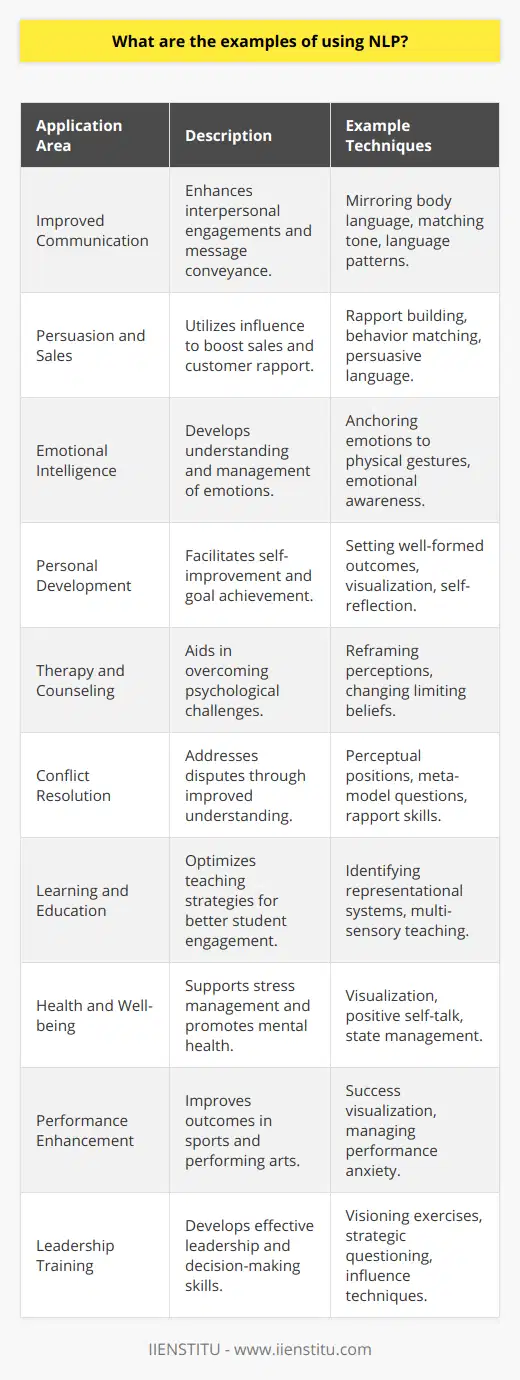
What is NLP in simple words and can you provide examples?
Understanding NLP
Natural Language Processing (NLP) refers to a rapidly advancing field within artificial intelligence (AI) that focuses on enabling computers to understand, interpret, and generate human language. Situated at the intersection of linguistics, computer science, and machine learning, NLP is concerned with developing algorithms and models that can analyze and interpret natural language data, such as text or speech, in a meaningful way.
Applications of NLP
One widespread application of NLP is sentiment analysis, which involves identifying the sentiment expressed in a piece of text, such as detecting positive, negative, or neutral emotions in customer reviews. Another example is machine translation, which allows for converting text from one language to another, as evidenced by popular tools like Google Translate.
Text Summarization and Keyword Extraction
NLP techniques are also employed in text summarization, where an algorithm effectively condenses a longer document into a shorter version, preserving only the most relevant information. Similarly, keyword extraction algorithms automatically identify the most important words or phrases in a text, assisting in tasks like information retrieval and search engine optimization.
Speech Recognition and Text-to-Speech
Speech recognition is another NLP application that has gained traction in recent years, with numerous virtual assistants like Siri and Alexa relying on this technology to convert spoken language into text. Conversely, text-to-speech systems enable the transformation of written text into spoken words, facilitating a more accessible interface for users with visual impairments or those who prefer listening to reading.
Chatbots and Virtual Assistants
The use of NLP extends to creating more sophisticated and context-aware chatbots and virtual assistants, capable of responding to complex user queries with human-like understanding. By leveraging NLP techniques, these systems can offer improved support, recommendations, and interactions, representing a significant advancement in the way that users engage with technology.
In conclusion, NLP plays a vital role in enhancing the ability of computers to comprehend and generate human language, paving the way for an even more seamless interaction between humans and machines. Through the numerous applications of NLP, such as sentiment analysis, machine translation, and speech recognition, this ever-evolving field of AI continues to transform our linguistic interactions with technology.
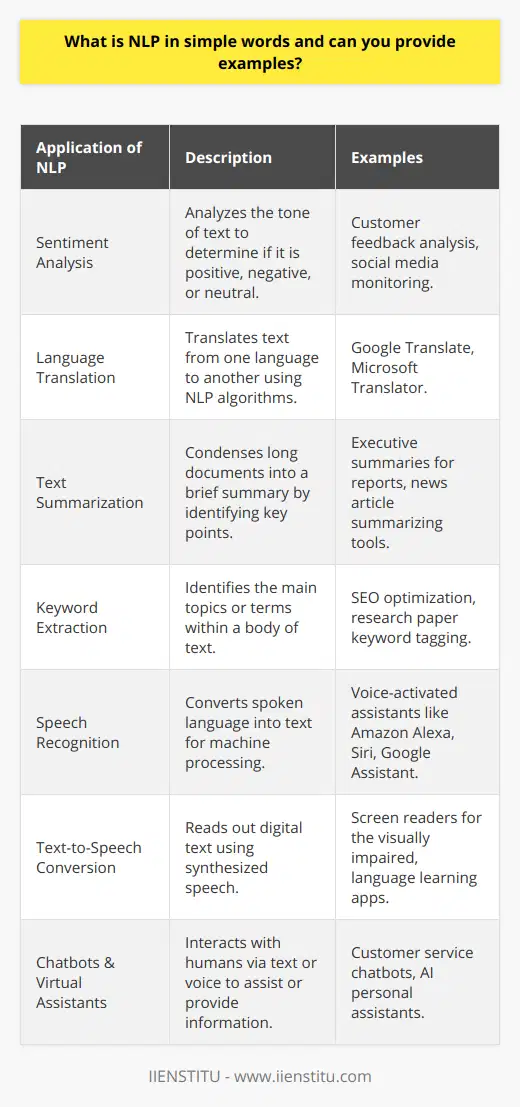
In which practical scenarios is the use of NLP most prominent?
Applications of NLP in Diverse Fields
Natural language processing (NLP) has seen widespread adoption across various industries due to its ability in understanding human language, enhancing communication, and ultimately improving efficiency. Some practical scenarios where NLP is most prominent include:
Healthcare Sector Improvements
In healthcare, NLP assists in analyzing patient records, summarizing clinical documents, and predicting healthcare outcomes. By extracting relevant information from textual data, medical professionals can devise informed treatment plans for patients.
Revolutionizing Customer Support
NLP is extensively utilized in customer support services, streamlining interactions between customers and businesses. Chatbots powered by NLP offer instant and accurate responses, leading to enhanced user experience, cost-saving, and overall customer satisfaction.
Social Media Analysis
Companies leverage NLP to gauge customer sentiments, identify trending topics, and address concerns by monitoring social media content. This information helps businesses to understand public opinion, make necessary changes, and ultimately refine their marketing strategies.
Sentiment Analysis
NLP facilitates sentiment analysis, enabling organizations to comprehend customer emotions behind reviews or comments. This practice aids businesses in detecting negative feedback and taking corrective actions, leading to better products and services.
Text Classification and Categorization
NLP finds applications in spam filtering and efficient email management. Advanced systems are capable of categorizing emails, segregating urgent messages, and detecting phishing attempts to enhance productivity and email security.
Voice Assistants and Smart Devices
The emergence of voice assistants and smart devices, such as Amazon's Alexa and Google Assistant, has increased the need for NLP. These technologies rely on NLP algorithms to interpret voice commands and perform tasks, ensuring a seamless user experience.
Legal Document Analysis
NLP proves crucial in the legal domain, enabling lawyers to quickly extract essential details from voluminous contracts, dispute resolutions, and legal databases. NLP simplifies the process by summarizing texts, thereby saving time and enhancing productivity.
Machine Translation Applications
NLP also powers machine translation, allowing users to interpret content in various languages. This advancement breaks down language barriers and enables seamless communication among individuals from diverse linguistic backgrounds.
In conclusion, NLP is at the forefront of technological advancements, enhancing human-machine interactions, and making tasks more efficient. From healthcare to customer support, social media analysis to legal document examination, the prominent use of NLP has brought forth significant improvements in numerous practical scenarios. Its continued development will undoubtedly shape the future of communication, productivity, and comprehension.
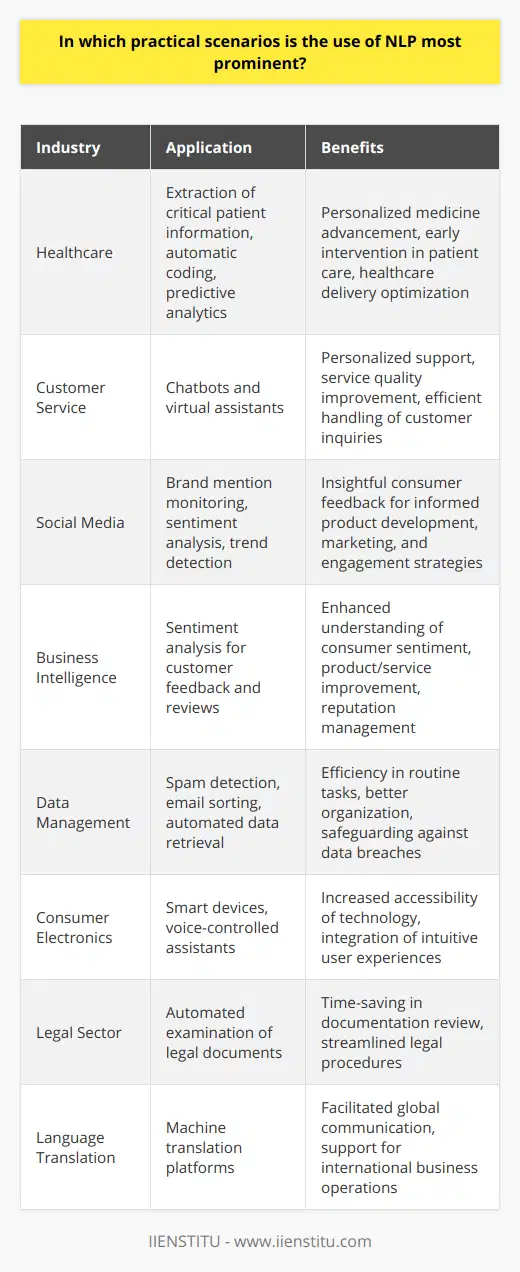
Could you elaborate on a typical example of NLP application in an academic setting?
NLP Application: Academic Text Analysis
A typical example of natural language processing (NLP) application in an academic setting is the analysis of academic texts such as research articles, conference papers, and student essays. NLP tools can be employed to automatically extract valuable insights and identify patterns within these texts.
Keyword Extraction and Summarization
Using NLP algorithms, researchers can extract keywords and phrases from academic texts, allowing them to quickly identify the main topics and concepts discussed in the publications. Additionally, NLP is capable of generating automatic summaries of lengthy texts, helping scholars to gain a general understanding of the content without reading the entire document.
Text Classification and Categorization
Classifying and categorizing academic texts according to their subject areas is an essential aspect of digital libraries and research databases. NLP techniques facilitate this process by analyzing the text content and assigning appropriate labels, organizing the documents in a structured manner that makes them easily accessible.
Plagiarism Detection
Academic integrity is of paramount importance in educational institutions. NLP algorithms can be utilized to detect potential plagiarism in academic texts by comparing a submitted document to a large corpus of reference material, identifying sentences or passages that have a high degree of similarity, and flagging them for further scrutiny.
Sentiment Analysis
Although sentiment analysis is commonly associated with social media data, it can also be employed in an academic context, particularly in the evaluation of peer review processes. By analyzing the language used by reviewers to provide feedback on research articles, NLP algorithms can potentially detect biases or unnecessary harshness in the critique, ensuring a more balanced and objective assessment.
Readability Assessment
Lastly, NLP algorithms can evaluate the readability of academic texts, assessing factors such as sentence complexity, vocabulary difficulty, and text cohesion. This enables educators to determine the suitability of a particular text for different student populations, as well as providing guidance for authors in improving the clarity and comprehensibility of their work.
In summary, NLP applications in an academic setting provide a range of functionalities that greatly benefit researchers, educators, students, and academic institutions. By automating various tasks related to text analysis, classification, and evaluation, NLP enhances both the accessibility and integrity of academic knowledge.
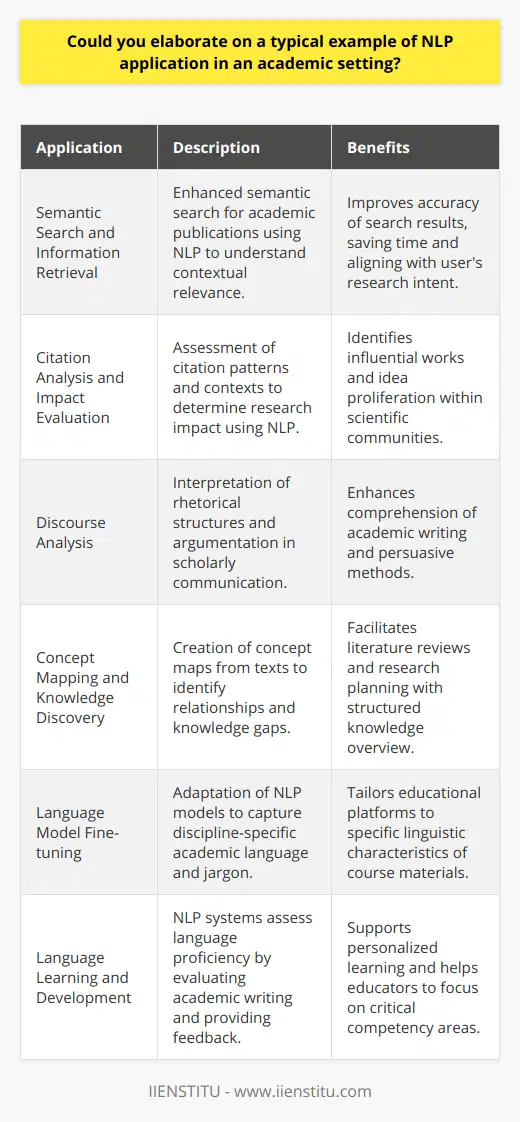
Are Alexa and Siri examples of NLP?
Understanding NLP
Natural Language Processing (NLP) is a subfield of artificial intelligence (AI) that focuses on enabling computers to comprehend, interpret, and generate human language in a manner that is both meaningful and appropriate. To determine whether Alexa and Siri are examples of NLP, it is essential to explore their underlying technology and functionality.
Alexa and Siri's Core Functions
Both Alexa and Siri are intelligent personal assistants designed by Amazon and Apple, respectively, to help users carry out tasks, answer
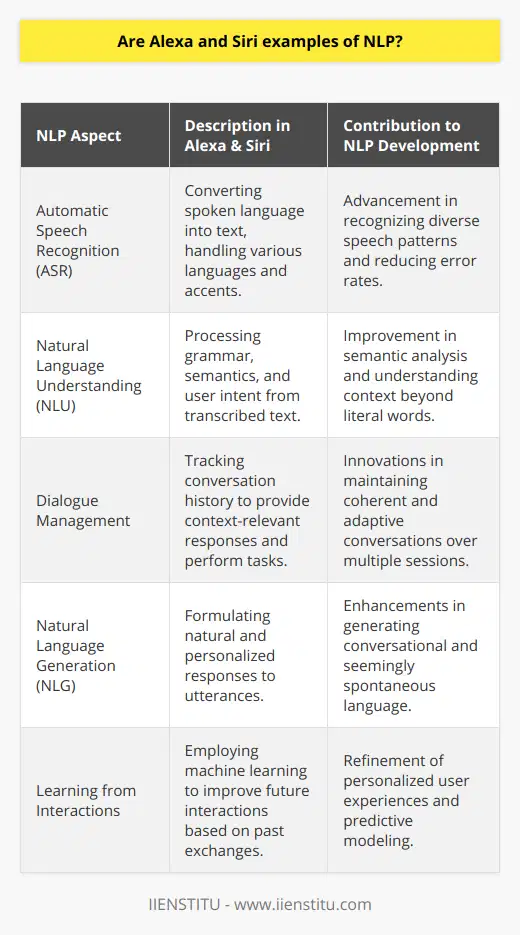
What does the term NLP encompass in the field of artificial intelligence?
NLP Definition and Importance
The term NLP, or Natural Language Processing, encompasses a diverse range of techniques and methodologies within the field of artificial intelligence (AI) targeting the neoteric task of comprehending, interpreting, and generating human language. NLP fosters seamless interactions between humans and machines while removing linguistic barriers that obstruct efficient communication.
Components of NLP
NLP consists of various subfields with distinct yet interrelated objectives. These subfields include but are not limited to syntax and parsing, semantics, pragmatics, and discourse. Syntax and parsing involve examining the structure of texts, while the semantics aspect focuses on understanding the meaning behind words and phrases. Pragmatics and discourse analysis examine the context and real-world scenarios in which communication takes place.
NLP Applications
Due to the versatility of NLP techniques, their applications span multiple domains beyond AI, such as linguistics, computational linguistics, and cognitive computing. Examples of NLP applications include voice recognition systems, language translation programs, information extraction, summarization, sentiment analysis, and chatbots.
Challenges and Future Directions
Despite the significant progress achieved in NLP, challenges continue to confront researchers, stemming from the dynamic nature and complexity of human language. These challenges include the accurate interpretation of sarcasm, idiomatic expressions, and handling ambiguities in linguistic structure. As NLP research advances, the focus would be on surmounting these challenges to improve the interpretative and generative capabilities of AI systems.
Over time, NLP's impact on AI will continue to amplify as interdisciplinary research efforts yield breakthroughs in areas like unsupervised learning, deep learning, and cognitive computing. Ultimately, NLP will profoundly enhance the ability of AI to better replicate human-like communication and comprehension, leading to smarter and more intuitive technologies.
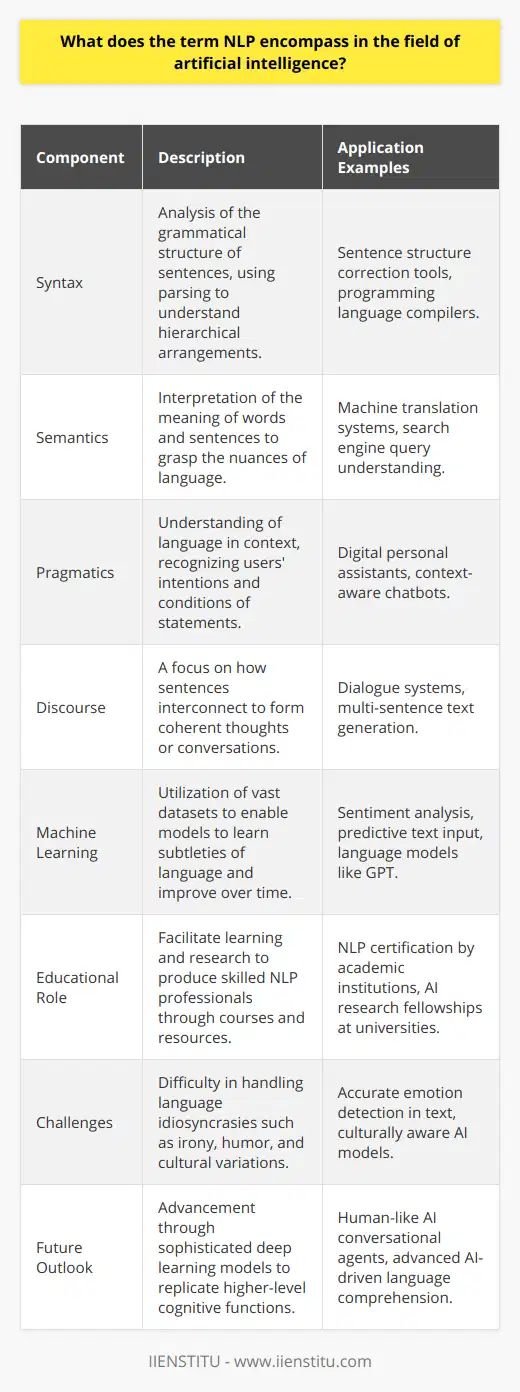
Can you provide examples of NLP applications in various industries?
NLP Applications in Healthcare
In the healthcare industry, NLP is used for medical data analysis, such as extracting information from electronic health records, identifying risk factors and diseases, and automating diagnosis processes. For instance, IBM's Watson for Oncology helps doctors identify cancer-treatment options.
Customer Service and Chatbots
Businesses employ NLP-based chatbots to handle customer inquiries, complaints, and feedback. Chatbots mimic human interactions, providing quick, relevant responses to customers, thereby reducing the workload of human operators and enhancing customer engagement.
Social Media Monitoring
Companies harness NLP techniques to analyze social media data, recognizing patterns and sentiments to gauge consumer opinions and feedback on their products and services. This helps businesses identify current trends and adapt their strategies accordingly to enhance customer satisfaction and drive sales growth.
Recruitment and Human Resources
In the HR domain, NLP applications can streamline the recruitment process by filtering and analyzing candidate information from large databases, identifying the most suitable applicants. NLP-powered tools also assist in analyzing employee performance and sentiment, aiding in better employee management and engagement.
Sentiment Analysis in Finance
Financial institutions employ NLP for sentiment analysis of stocks and securities, using algorithms to determine public sentiments from news articles, financial documents, and social media posts. This information helps investors and traders make informed decisions, shaping investment strategies.
Legal and Compliance
Legal professionals can utilize NLP tools to expedite contract analysis, identify potential legal risks, and extract specific terms from vast sources of documents. In compliance management, NLP can recognize non-compliant patterns in communications, mitigating the risk of legal and regulatory breaches.
NLP in Education
Education sectors are gradually adopting NLP technology for automated essay grading, plagiarism detection, and adaptive learning systems. These applications enhance teaching practices, streamline assessment processes, and help institutions improve student performance.
Research and Development
Lastly, NLP is employed in research and development to streamline information retrieval, summarizing long texts, and identifying patterns in scientific literature. This assists in expediting the research process, improving the overall efficiency of research projects.
In conclusion, Natural Language Processing is a versatile technology that has permeated various industries, providing practical solutions to drive efficiency, customer satisfaction, and overall growth.
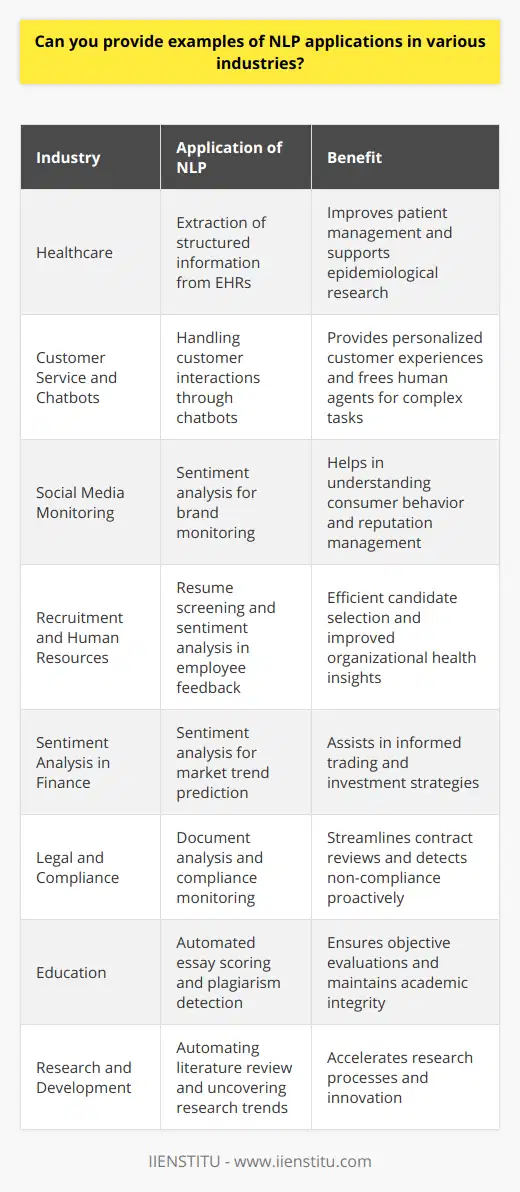
What is NLP and can you provide an example of its application in linguistics?
**Introduction to NLP**
Natural Language Processing (NLP) is a subfield of artificial intelligence and linguistics that focuses on equipping computers with the ability to understand, interpret, and generate human language. It essentially bridges the gap between human communication and computer understanding, enabling machines to comprehend and process textual or spoken language data.
**Example: Machine Translation**
A prominent example of NLP in linguistics is machine translation, a technology that automatically translates text or speech from one language to another. Google Translate, for instance, employs advanced NLP techniques to identify patterns, rules, and structures in the source language and generate equivalent translations in the target language. By leveraging different algorithms and models, machine translation systems attempt to provide natural, accurate, and contextually relevant translations that mirror human-like understanding and fluency.
**Application: Sentiment Analysis**
Another practical application of NLP in linguistics is sentiment analysis, which involves determining people's opinions, emotions, or attitudes towards a specific topic, product, or service. This process makes use of NLP techniques such as text mining, natural language understanding, and computational linguistics to analyze textual data and classify sentiments as positive, negative, or neutral. Sentiment analysis is widely employed by companies to gauge customer satisfaction, monitor brand reputation, and inform decision-making strategies.
**Syntax and Semantics Processing**
In order to effectively comprehend and process human language, NLP often deals with various linguistic components such as syntax (the arrangement of words and phrases in a sentence) and semantics (the meaning derived from the words and their relationships). NLP techniques may include parsing, which breaks down sentences into their constituent parts, and semantic role labeling, which identifies the roles and relationships of words within the sentence. These methods contribute to the development of applications that accurately interpret and produce meaningful language output.
**Conclusion: NLP's Impact on Linguistics**
In summary, Natural Language Processing enhances computer systems' ability to decipher and generate human language, playing a critical role in the advancement of linguistic applications. By providing innovations such as machine translation and sentiment analysis, NLP has revolutionized the ways in which we communicate, access information, and make data-driven decisions. As the field continues to grow and evolve, NLP will undoubtedly bring about further transformations to the study of linguistics and beyond.
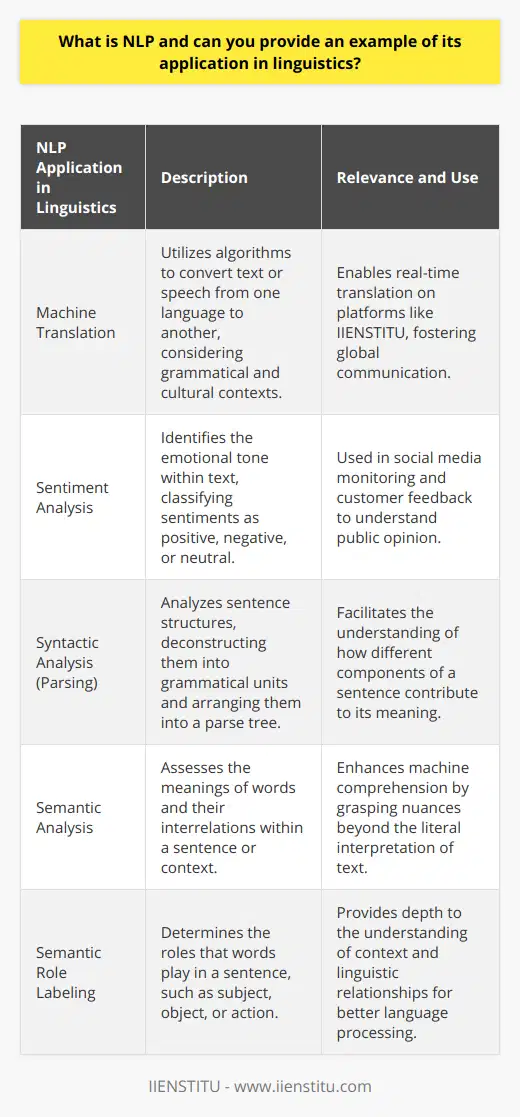
How does NLP contribute to the development of human-computer interaction, and what are some notable use cases?
Enhancing Human-Computer Interaction
Natural Language Processing (NLP) substantially contributes to the advancement of human-computer interaction (HCI) by facilitating the comprehension of human languages, enabling computers to interpret, understand, and deploy appropriate responses. This, in turn, allows for more user-friendly and practical communication channels that cater to a variety of applications and industries.
Speech Recognition Systems
One prominent use case involves speech recognition systems, which employ NLP algorithms to convert spoken words into text or commands. Notable examples include personal assistants like Siri, Google Assistant, and Amazon's Alexa, which provide on-demand assistance by understanding voice commands and responding appropriately. These systems enhance the convenience and accessibility for users, especially those with physical limitations or disabilities.
Textual Analysis
Another significant contribution of NLP to HCI is in textual analysis, focusing on reviewing massive amounts of text, extracting essential information, and determining sentiment. Notable use cases consist of customer service tools that mine customer feedback and social media posts to identify trends, user preferences, and potential issues. Consequently, this information benefits businesses in making data-driven decisions and tailoring their products or services to cater to customer needs better.
Machine Translation
NLP also plays a considerable role in machine translation, enabling real-time translation of text and speech across diverse languages, thus breaking down language barriers. Applications like Google Translate, which utilizes NLP techniques, have significantly improved communication and collaboration among global teams, tourists, and business professionals, fostering global understanding and productivity.
Text Prediction and Autocorrection
Additionally, NLP aids in text prediction and autocorrection features, which improve the user experience by offering seamless typing experiences, minimizing spelling and grammar errors, and suggesting personalized text completions. Examples include mobile keyboard applications such as SwiftKey and Gboard, which utilize NLP algorithms to learn typing patterns and personalize the writing experience, significantly reducing the time and effort required for composing text messages, emails, and documents.
In conclusion, NLP plays a vital role in advancing human-computer interaction by widening communication channels, facilitating understanding of human languages, and enhancing various applications relevant to everyday life. As NLP technology progresses, it is expected to revolutionize various aspects of human-computer interaction further and make digital interfaces more intuitive, efficient, and accessible.
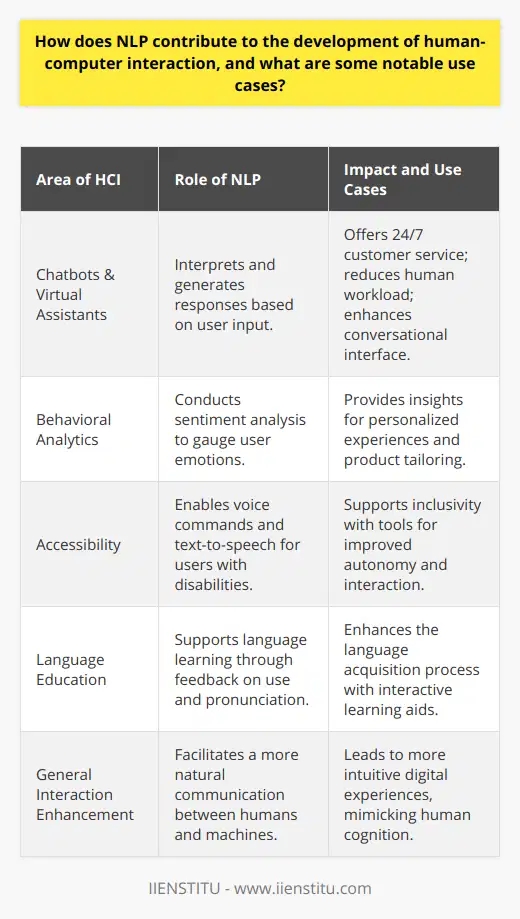
What does NLP encompass in the context of machine learning and computational linguistics, and can you provide an example of its implementation in a real-world scenario?
**Definition and Context**
Natural Language Processing (NLP) can be defined as a subfield of machine learning and computational linguistics, concerned with the development of algorithms via intelligent systems that interact with human language. NLP allows machines to analyze, understand and effectively process real-life textual data or human speech, aiming for seamless communication between humans and computers.
**Components of NLP**
NLP encompasses various components which play a crucial role in the overall understanding and processing of human language. Some key components include:
Syntactic Analysis: Sentence structure and parsing, including the study of grammatical relationships between words.
Semantic Analysis: Understanding the meaning and intent behind the syntactic structure, involving concepts such as word disambiguation and context-based interpretation.
Pragmatic Analysis: Taking into account real-world knowledge and the context of the speaker and listener to get the intended meaning and appropriate response.
Discourse Analysis: Understanding text and speech patterns in larger contexts such as linguistic cues, socio-cultural frameworks, and conversational structures.
**Real-World Example**
An example of NLP implementation in a real-world scenario can be observed in the deployment of virtual personal assistants commonly found in smartphones and smart speakers, such as Apple's Siri, Amazon's Alexa, and Google Assistant. These AI-powered assistants utilize NLP techniques to process and interpret natural language input, enabling a more human-like interaction with the user. They can perform tasks, provide information, and even engage in simple conversations by listening to voice commands, understanding their context, and generating appropriate responses.
In conclusion, NLP is a dynamic field in machine learning and computational linguistics, aimed at bridging the communication gap between humans and machines. The widespread use of virtual personal assistants in our daily lives testifies to the practical effectiveness of NLP techniques and their potential to revolutionize the way we interact with technology.
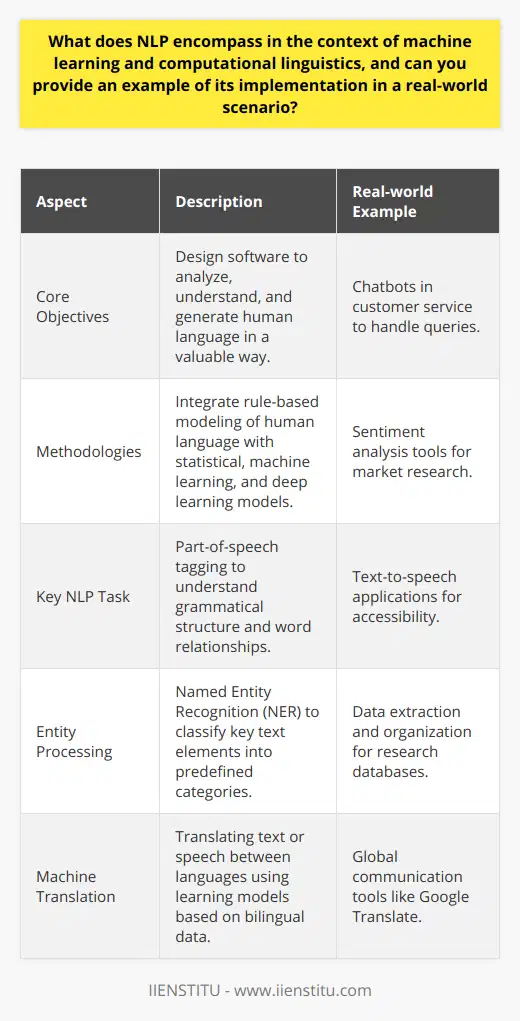
What is the relationship between NLP and cognitive linguistic theory?
**NLP and Cognitive Linguistic Theory: An Overview**
Natural Language Processing (NLP) and cognitive linguistic theory share a fundamental relationship, as both domains are concerned with the study of human language and cognition. NLP, a subfield of artificial intelligence, focuses on enabling computers to understand, interpret, and generate human language. Cognitive linguistic theory, on the other hand, examines the nature of language as tied to cognitive processes, such as categorizations, conceptualizations, and mental representations.
**Diving Deeper: Cognition and Language**
At the heart of the relationship between NLP and cognitive linguistics is the assumption that language is not an isolated and autonomous system but instead intricately connected to cognition and perception. Cognitive linguists argue that language shapes and reflects an individual's mental processes, while NLP explores the practical implications of these linguistic principles in the context of computational systems. A fundamental goal of NLP research is to develop algorithms and models capable of accurately replicating human language processing capabilities, drawing on insights from cognitive linguistic theory.
**Mutually Beneficial Relationship**
The contributions of cognitive linguistic theory to NLP are exemplified in various NLP techniques. For instance, semantic analysis tasks, such as disambiguation and metaphor identification, often leverage cognitive linguistic theories, such as conceptual metaphor theory, which posits that metaphors structure our thoughts and shape our experiences. Similarly, cognitive linguistic theories on mental representations and schemas are crucial for designing NLP models that can interpret textual context and ascertain meaning.
In return, NLP's computational methods hold the potential to contribute to cognitive linguistic theory by providing empirical evidence and quantitative analysis of linguistic phenomena. NLP algorithms can help identify linguistic patterns and trends that back cognitive linguistic hypotheses, leading to a deeper understanding of the cognitive aspects of language and paving the way for more advanced theories.
**Shared Challenges and Future Directions**
Both NLP and cognitive linguistic theory face common challenges, such as resolving ambiguity and understanding the complexities of human language, like sarcasm, idiomatic expressions, and cultural nuances. Combining the strength of cognitive linguistics and NLP allows researchers to tackle these challenges collaboratively and build comprehensive and coherent models of language and cognition.
As advancements in artificial intelligence, machine learning, and deep learning continue, the relationship between NLP and cognitive linguistic theory will evolve. By integrating cognitive linguistic insights into NLP models and applications, researchers and engineers can work towards bridging the gap between human and machine language understanding, ultimately enhancing the effectiveness of language-based technologies and deepening our understanding of the human mind.
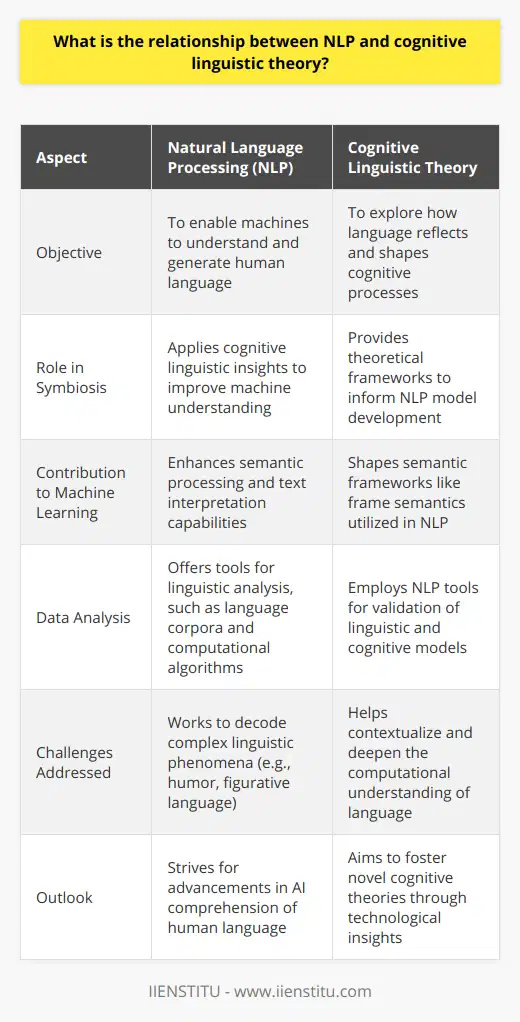
How has the development of NLP algorithms influenced the field of psycholinguistics?
Influence on Psycholinguistic Models
The development of Natural Language Processing (NLP) algorithms has significantly influenced the field of psycholinguistics, the study of language and the cognitive processes underlying language use. NLP tools have enabled researchers to investigate various aspects of linguistic processing, informing psycholinguistic theories and leading to the construction of new models that better represent the underlying cognitive mechanisms.
Enhanced Data Collection and Analysis
NLP algorithms have revolutionized the way researchers collect and analyze language data, transforming psycholinguistics into a more data-driven field. These algorithms facilitate automatic extraction of features from large-scale linguistic datasets, allowing researchers to explore complex linguistic phenomena in more depth. Consequently, the increased availability and reliability of linguistic data have led to more robust and comprehensive findings, providing valuable insights into the cognitive processes involved in language comprehension and production.
Computational Models in Psycholinguistics
Another significant impact of NLP algorithms on psycholinguistics is the integration of computational modeling techniques. Computational models can simulate cognitive processes, providing a quantitative and testable framework to investigate language-related cognitive processes. By using NLP algorithms, researchers are able to build models that generate predictions about behavior, which can then be empirically tested, driving further model refinement and the understanding of underlying mechanisms. Additionally, these models can contribute to the improvement of NLP systems by incorporating cognitive constraints or simulating human-like processing.
NLP Algorithms Informing Psycholinguistic Theories
One of the remarkable outcomes of the integration of NLP algorithms in psycholinguistics is their ability to inform and refine theoretical explanations of language processing. By leveraging NLP approaches, psycholinguists can test the consistency and plausibility of their theories, thereby validating or revising them based on empirical results. This iterative process of theory-driven development and data-driven evaluation has led to a deeper understanding of the cognitive mechanisms underlying language use.
In conclusion, the development of NLP algorithms has had a profound impact on psycholinguistics, enhancing the collection and analysis of linguistic data, fostering the integration of computational models, and informing theoretical explanations of language processing. As NLP algorithms continue to advance, their influence on the field of psycholinguistics is expected to expand, further enriching our understanding of the cognitive processes involved in language comprehension and production.

What ethical considerations arise in the development and application of NLP technologies?
Ethical Challenges in NLP Development
The development and application of natural language processing (NLP) technologies come with various ethical considerations. One primary concern is the potential for these technologies to perpetuate and amplify societal biases. NLP algorithms learn from vast datasets, often containing language data gathered from the internet or other forms of human communication. As a result, these models may internalize and perpetuate biases that are present in the training data.
Addressing Privacy and Consent
Another ethical issue associated with NLP technologies is privacy and consent. Text analysis and sentiment analysis algorithms often collect and process large amounts of private and personal information without explicit user consent. This may lead to potential violations of privacy, as well as the misuse of sensitive information. Furthermore, NLP systems could be used for surveillance purposes, potentially infringing on individuals' privacy rights.
Ensuring Fairness and Equal Representation
NLP technologies have the potential to exclude or discriminate against certain groups due to linguistic or cultural differences. Ensuring that these technologies are developed with diverse and inclusive datasets is crucial to prevent the exclusion or marginalization of particular segments of the population. For instance, the performance of NLP algorithms may be lower for minority languages, dialects, or cultural contexts, contributing to inequity and a digital divide in society.
Considering the Impact on Employment
The automation of language-related tasks, such as translation, content generation, and customer service, has substantial implications for the job market. While NLP technologies may lead to increased efficiency and productivity, it is essential to consider the potential displacement of human labor and its subsequent impact on employment opportunities. Ethical considerations should also include the upskilling and retraining of workers, as well as the need for responsible AI deployment in the workplace.
Preventing Misuse and Harm
There is a risk that NLP technologies could be used for harmful purposes, such as misinformation, propaganda, or cyberbullying. Developing measures to prevent and mitigate the misuse of NLP systems is an ethical responsibility for both developers and organizations using these technologies. Ensuring transparency, accountability, and the implementation of strong ethical guidelines can help minimize the risk of harm associated with the development and application of NLP technologies.
In conclusion, the development and application of NLP technologies are accompanied by various ethical concerns, including the perpetuation of biases, privacy and consent issues, fairness and equal representation, the impact on employment, and preventing misuse and harm. Addressing these ethical considerations is crucial for the responsible development and deployment of NLP technologies.
